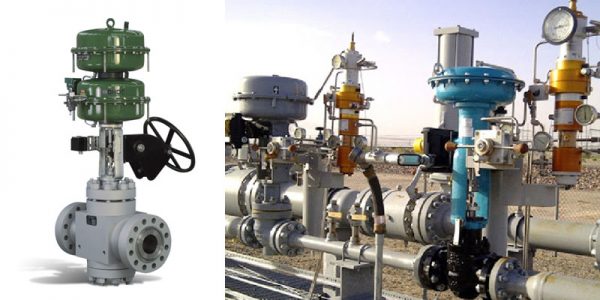Comprehending the Importance of Control Valves in Process Automation
Comprehending the Importance of Control Valves in Process Automation
Blog Article

Maximize Power Financial Savings and Convenience With Advanced Structure Automation Controls
In the realm of contemporary architecture and facility monitoring, the combination of innovative structure automation manages stands as a crucial innovation. By using the power of automation, structures can adjust, respond, and advance in means that were once unimaginable.
Energy Efficiency Perks
Power efficiency benefits can considerably minimize power intake and operational prices in structures. Energy-efficient systems, such as sophisticated building automation controls, can maximize the use of sources like lighting, air conditioning, and heating, leading to reduced power expenditures over time.
In addition, enhanced energy effectiveness can extend the lifespan of building tools and systems. By running more effectively, cooling and heating systems, lighting fixture, and various other building parts experience less wear and tear, resulting in minimized upkeep and substitute expenses. Additionally, energy-efficient buildings frequently command higher residential property worths and rental rates, providing lasting monetary benefits to owners.
In addition, energy effectiveness can boost owner comfort and performance. Effectively managed indoor atmospheres with optimal lights and thermal problems produce a more pleasurable and favorable office, leading to boosted worker satisfaction and efficiency. On the whole, the energy performance advantages associated with innovative building automation controls are diverse, encompassing cost savings, ecological stewardship, and passenger health.
Boosted Comfort Control
Enhancing comfort control in building atmospheres calls for an advanced combination of sophisticated automation systems for ideal occupant wellness. By utilizing sophisticated structure automation controls, facilities can customize the indoor environment to meet the details demands and preferences of passengers. These systems enable accurate guideline of lighting, temperature level, and air flow, producing a effective and comfy atmosphere. Resident complete satisfaction and productivity are closely connected to thermal comfort, making it vital to have systems in position that can adapt to changing conditions in real-time.
By including these sophisticated controls, buildings can not only boost comfort but also enhance energy effectiveness by optimizing system procedures based on actual tenancy and usage patterns. Eventually, focusing on resident convenience through advanced automation systems leads to an extra satisfying and healthier indoor setting.
Operational Effectiveness Improvements

Additionally, the execution of real-time tracking and analytics tools enables building operators to identify energy ineffectiveness and operational anomalies promptly. By continually keeping track of power use patterns and system efficiency metrics, modifications can be made in real-time to enhance power consumption and ensure peak operational effectiveness. control valves. In addition, including need reaction strategies into structure automation controls can even more improve functional efficiency by dynamically changing power use based on grid problems and pricing signals
Indoor Climate Optimization
Effective interior climate optimization is an essential aspect of structure automation controls, making certain residents' convenience and well-being while optimizing energy savings. By utilizing sophisticated sensors and controls, constructing automation systems can continuously check and adjust temperature, humidity degrees, air quality, imp source and ventilation to develop an ideal indoor setting. Maintaining comfy and constant conditions not only improves owner contentment but also boosts efficiency and general wellness.
Interior environment optimization likewise plays an essential function in energy performance. By fine-tuning air flow, home heating, and air conditioning systems based upon real-time information and occupancy patterns, building automation controls can significantly decrease power intake - control valves. For circumstances, carrying out techniques such as demand-controlled air flow and thermal zoning can aid decrease power waste while guaranteeing that each location of the structure gets the needed conditioning.

Lasting Setting Production
Structure automation manages not just maximize indoor environment conditions for power effectiveness and owner convenience but also lay the structure for producing a sustainable atmosphere through critical management of systems and resources. By integrating sophisticated structure automation modern technologies, such as sensors, actuators, and smart software application, centers can check and readjust energy usage in real-time to lessen waste and lower their carbon impact. These systems enable predictive upkeep, recognizing prospective issues prior to they intensify and optimizing tools performance to improve long life and effectiveness.
In addition, lasting atmosphere development expands beyond power management to include water conservation, waste decrease, and interior air quality enhancement. Structure automation controls can manage water use, spot leaks, and ensure appropriate waste disposal methods, adding to general sustainability initiatives. Additionally, by managing and monitoring ventilation and filtering systems, these technologies enhance resident health and wellness and performance while decreasing power usage related to a/c procedures.
Conclusion
In conclusion, progressed structure automation regulates offer considerable benefits in regards to power savings, convenience control, operational efficiency, indoor climate optimization, and producing a sustainable atmosphere. By applying these controls, buildings can achieve optimal efficiency while minimizing energy consumption and enhancing resident comfort. It appears that making use of sophisticated automation modern technology is essential in enhancing building performance and producing a more lasting future.
Power performance advantages can substantially reduce power intake and operational costs in buildings. Generally, the energy effectiveness advantages linked with innovative building automation controls are diverse, incorporating expense financial savings, environmental stewardship, and owner wellness.
Additionally, incorporating need feedback techniques right into structure automation controls can better improve functional efficiency by dynamically adjusting useful site energy usage based on grid problems and prices signals.
Structure automation controls not just enhance interior climate problems for power performance and resident convenience yet additionally lay the foundation for producing a lasting setting via calculated management of systems and sources.In verdict, advanced structure automation regulates offer significant benefits in terms of power cost savings, convenience control, functional performance, indoor environment optimization, and creating a sustainable atmosphere.
Report this page